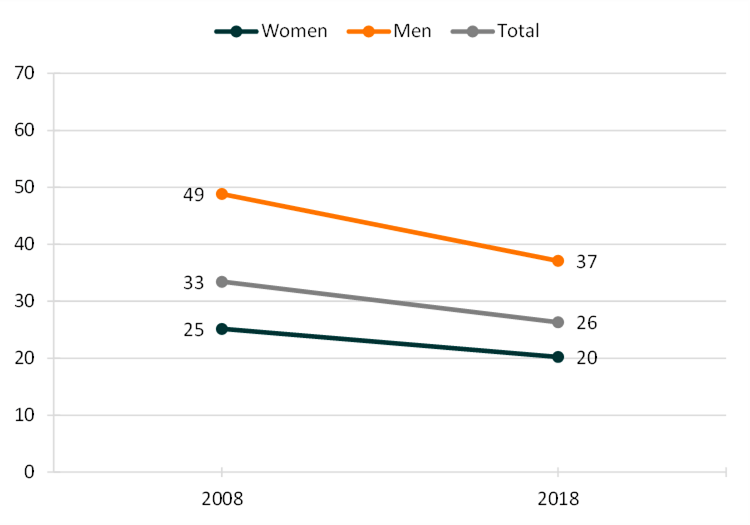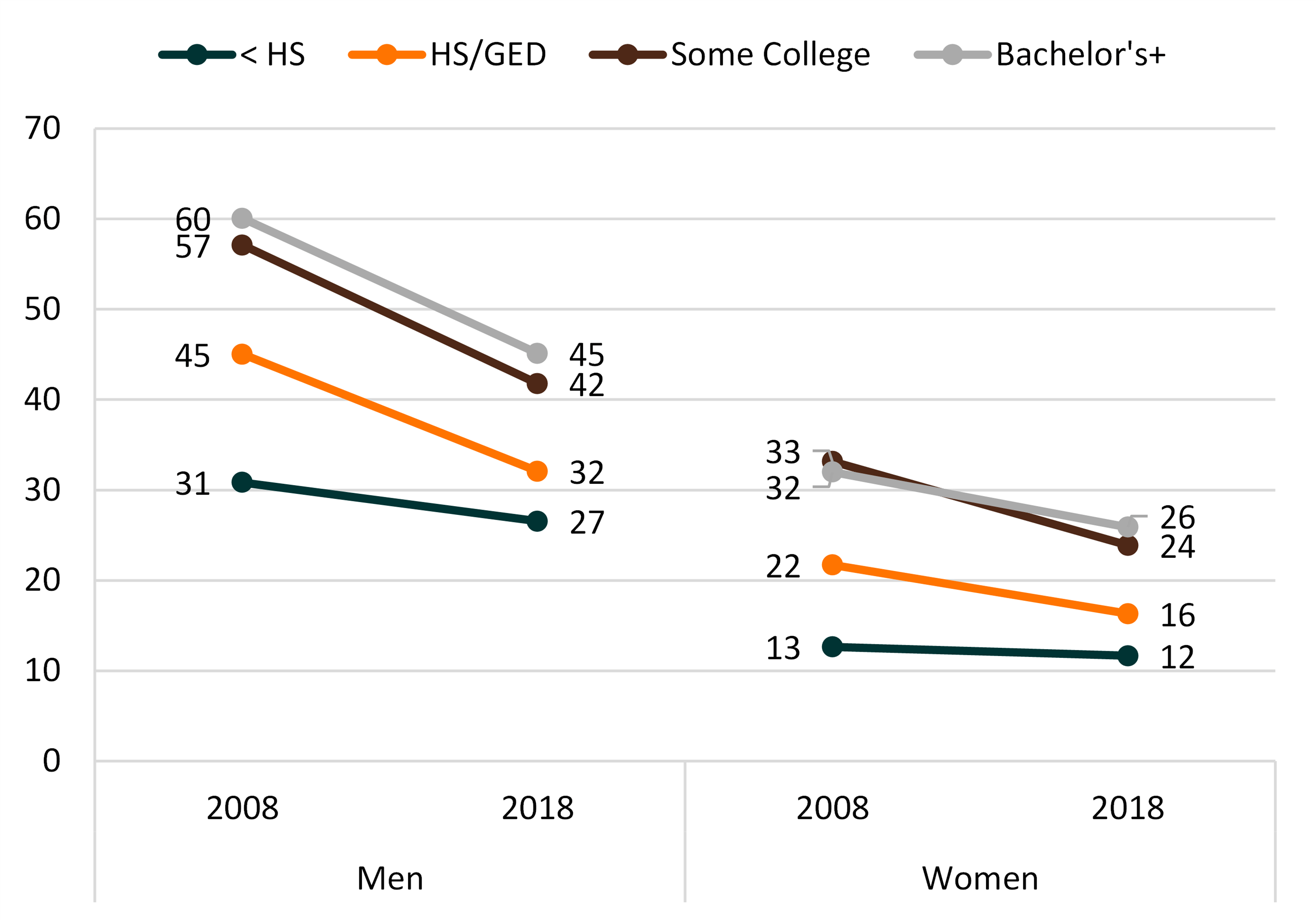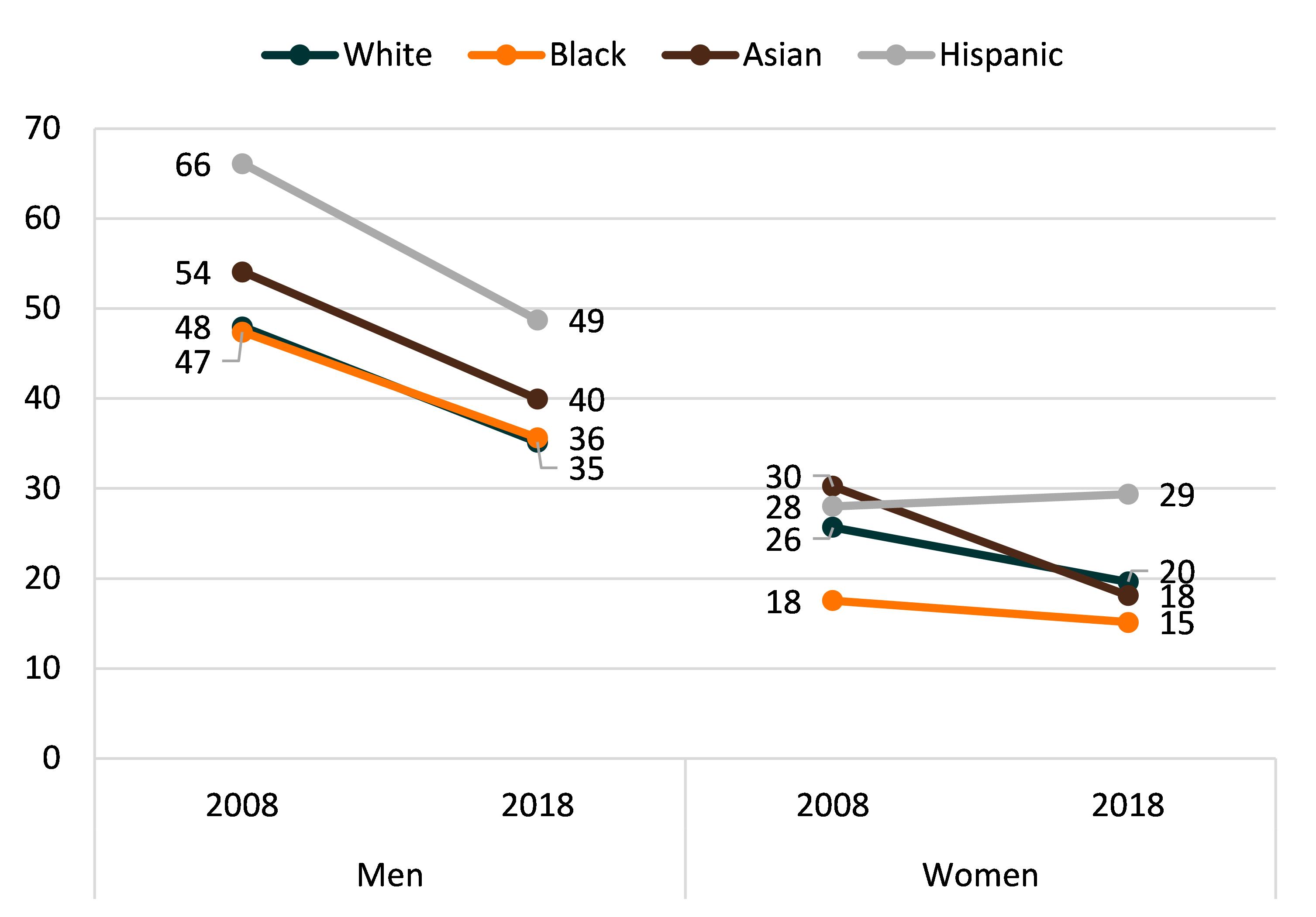Ten Years of Change in Remarriage
Family Profile No. 20, 2020
Author: Leslie Reynolds
Nearly half of all marriages in the U.S. end in divorce (Amato, 2010; Cherlin, 2010), and the remarriage rate has declined steadily in recent decades (Brown & Lin, 2013; Schweizer, 2019). Using the 2008 and 2018 American Community Survey (ACS), we examine change over time in the remarriage rate (defined as the number of marriages per 1,000 divorced or widowed individuals). Further, we differentiate between men and women and examine variation in decadal change by educational attainment and race/ethnicity. This profile is an update to previous profiles on the U.S. remarriage rate (FP-14-10, FP-12-14, FP-18-16). In 2018, there were 26 remarriages per 1,000 men and women aged 18 and older who were eligible for a remarriage, down from 33 remarriages in 2008.
Change in the Remarriage Rate by Gender
- The remarriage rate is consistently higher for men than for women, at 37 per 1,000 vs. 20 per 1,000 in 2018.
- The decline in rates from 2008 to 2018 was about twice as large for men (12 percentage points) as women (5 percentage points).
Figure 1. Remarriage Rate by Gender, 2008 & 2018

Source: NCFMR analyses of ACS 2008 & 2018 1-year estimates
Note: This profile estimates remarriage rates based on adults (18 and older) at risk of remarriage in the past 12 months. Men and women at risk are divorced or widowed.
Change in the Remarriage Rate by Gender and Education
- For both men and women, remarriage rates are highest among those with a bachelor’s degree or more.
- Although the rate of remarriage declined among all education groups, women with some college education experienced the greatest decline since 2008 (from 33 per 1,000 to 24 per 1,000).
- Among men, those with some college education and those with at least a college degree experienced the largest declines, both decreasing by 15 percentage points.
Figure 2. Remarriage Rate by Gender and Education, 2008 & 2018

Change in the Remarriage Rate by Gender and Race/Ethnicity
- There are significant differentials in the remarriage rates for men and women by race/ethnicity.
- In 2018, Hispanic men had the highest rate of remarriage (49 per 1,000), whereas White men had the lowest (35 per 1,000).
- Among men, the decline since 2008 was greatest for Hispanics–dropping by 17 percentage points.
- Among men, the decline since 2008 was greatest for Hispanics–dropping by 17 percentage points.
- Like their male counterparts, Hispanic women had the highest rate of remarriage (29 per 1,000). However, Black women had the lowest rate of remarriage at 15 per 1,000.
- Since 2008, Asian women experienced the greatest absolute decline in remarriage rate (30 versus 18 per 1,000).
Figure 3. Remarriage Rate by Gender and Race/Ethnicity, 2008 & 2018


The remarriage rate is consistently higher for men than for women, at 37 per 1,000 vs. 20 per 1,000 in 2018.

Data Source
U.S. Census Bureau; American Community Survey (ACS), One-Year Public Use Microdata Sample (PUMS), 2018.
References
Amato, P. R. (2010). Research on divorce: Continuing trends and new developments. Journal of Marriage and Family, 72(3), 650-666. DOI: 10.1111/j.1741-3737.2010.00723.x
Brown, S. L., & Lin, I.-F. (2013). Age Variation in the remarriage rate, 1990-2011. Family Profiles, FP-13-17. Bowling Green, OH: National Center for Family & Marriage Research. https://www.bgsu.edu/content/dam/BGSU/college-of-arts-and-sciences/NCFMR/documents/FP/FP-13-17.pdf
Cherlin, A. (2010). Demographic trends in the United States: A review of research in the 2000s. Journal of Marriage and Family, 72(3), 403-419. DOI: 10.1111/j.1741- 3737.2010.00710.x
Schweizer, V. (2019). The retreat from remarriage, 1950-2017. Family Profiles, FP-19-17. Bowling Green, OH: National Center for Family & Marriage Research. https://doi.org/10.25035/ncfmr/fp-19-17
Sweeney, M. (2010). Remarriage and stepfamilies: Strategic sites for family scholarship in the 21st century. Journal of Marriage & Family 72(3), 667-684. DOI: 10.1111/j.1741- 3737.2010.00724.x
Suggested Citation
Reynolds, L. (2020). Ten years of change in the U.S. Remarriage rate, 2008 & 2018. Family Profiles, FP-20-20. National Center for Family & Marriage Research. https://doi.org/10.25035/ncfmr/fp-20-20
Updated: 11/12/2025 09:35AM

 Nearly half of all marriages in the U.S. end in divorce (Amato, 2010; Cherlin, 2010), and the remarriage rate has declined steadily in recent decades (Brown & Lin, 2013; Schweizer, 2019). Using the 2008 and 2018 American Community Survey (ACS), we examine change over time in the remarriage rate (defined as the number of marriages per 1,000 divorced or widowed individuals). Further, we differentiate between men and women and examine variation in decadal change by educational attainment and race/ethnicity. This profile is an update to previous profiles on the U.S. remarriage rate (FP-14-10, FP-12-14, FP-18-16). In 2018, there were 26 remarriages per 1,000 men and women aged 18 and older who were eligible for a remarriage, down from 33 remarriages in 2008.
Nearly half of all marriages in the U.S. end in divorce (Amato, 2010; Cherlin, 2010), and the remarriage rate has declined steadily in recent decades (Brown & Lin, 2013; Schweizer, 2019). Using the 2008 and 2018 American Community Survey (ACS), we examine change over time in the remarriage rate (defined as the number of marriages per 1,000 divorced or widowed individuals). Further, we differentiate between men and women and examine variation in decadal change by educational attainment and race/ethnicity. This profile is an update to previous profiles on the U.S. remarriage rate (FP-14-10, FP-12-14, FP-18-16). In 2018, there were 26 remarriages per 1,000 men and women aged 18 and older who were eligible for a remarriage, down from 33 remarriages in 2008.
